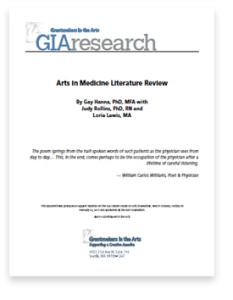
Author: Gay Hanna, PhD, MFA; Judy Rollins, PhD, RN; and Lorie Lewis, MA
Publication Year:
Media Type: Report
Summary:
The purpose of this literature review on arts in medicine is to examine reports and studies that illuminate the role artists and arts organizations can and do play in healthcare, especially in clinical settings. The approach used in this review is a holistic one — looking at what authors have to say about the arts and healing in relationship to individual preferences and cultural norms. [p. 3]
Abstract:
A growing body of research is bringing attention to how the arts — including literature, performing and visual arts, as well as architecture and design — can greatly enhance the healthcare experience (Lambert, 2016). Arts in medicine contributes to improved healthcare outcomes, better patient and staff satisfac-tion, and lower healthcare costs (Clift & Camic, 2016). Established as a field in the 1990s, arts in medicine programming in clinical settings usually developed as part of university healthcare systems in partnership with community based artists and arts organizations (Wikoff, 2004). Surveys conducted in 2003 and 2007 by the Joint Commission on Accreditation of Healthcare Organizations (JCAHO) — now called The Joint Commission — found the arts were being used in a wide range of services in over 50% of US hospitals and other healthcare facilities (State of the Field Committee, 2009).
Why now? The 21st century healthcare paradigm is shifting away from a medical model driven by the protocols of disease focusing on cure. It is now becoming a system based on the caring for the whole person in order to sustain high quality of life throughout treatments and to better manage ongoing care (Serlin, 2007). This new progressive system of cure and care demands an integrated approach to healing. Because of the intrinsic nature of the arts to nurture and comfort individuals at difficult times across the lifespan, as well as their ability to create environments conducive to healing and renewal for both the patient and caregiver, the arts have unprecedented opportunities to play a vital role in this new human-istic model of healthcare (Christenson, 2014; Hanna, Patterson, Rollins, & Sherman, 2011).
The purpose of this literature review on arts in medicine is to examine reports and studies that illuminate the role artists and arts organizations can and do play in healthcare, especially in clinical settings. The approach used in this review is a holistic one — looking at what authors have to say about the arts and healing in relationship to individual preferences and cultural norms. This report reviews studies support-ing the use of the arts in medicine across the lifespan; methods of delivering the arts to support health-care environments; group and individual art making; and professional development and training for caregivers. Finally, the report also gathers author recommendations for funders to consider when invest-ing in arts in medicine, along with ways to measure impact to build sustainability. [p.3]
Arts & Intersections: Health & Wellness
Categories:
ADDITIONAL BIBLIOGRAPHICAL INFORMATION
PUBLISHER INFORMATION
Name: Grantmakers in the Arts
Website URL: http://www.giarts.org